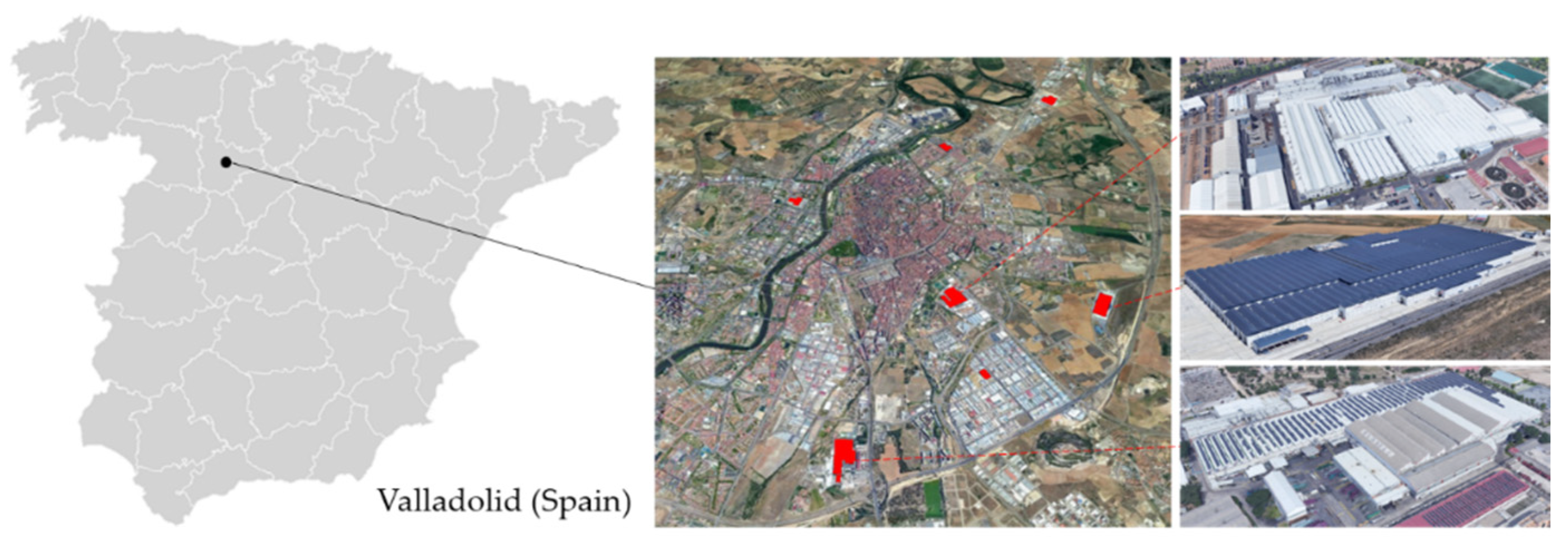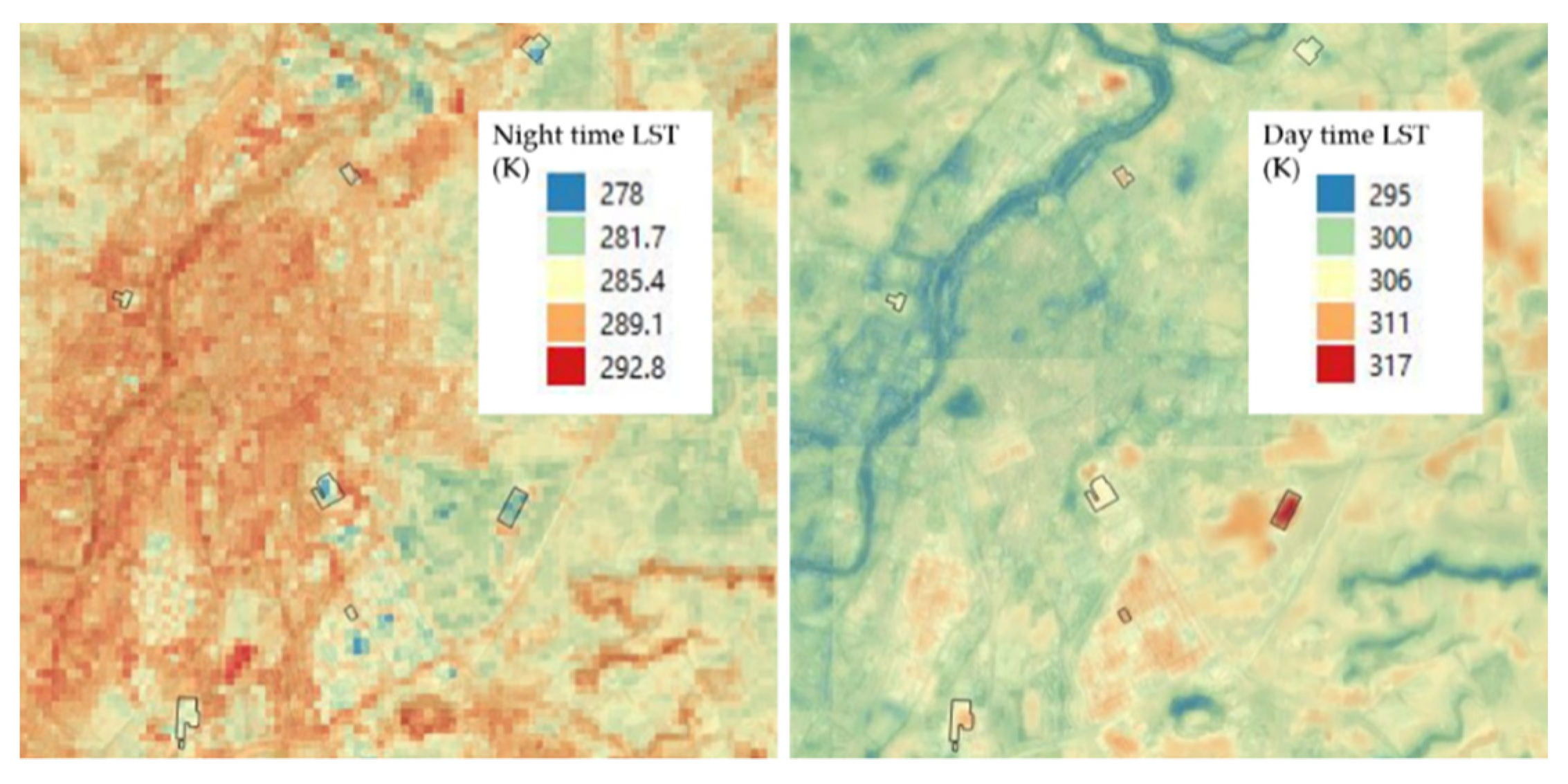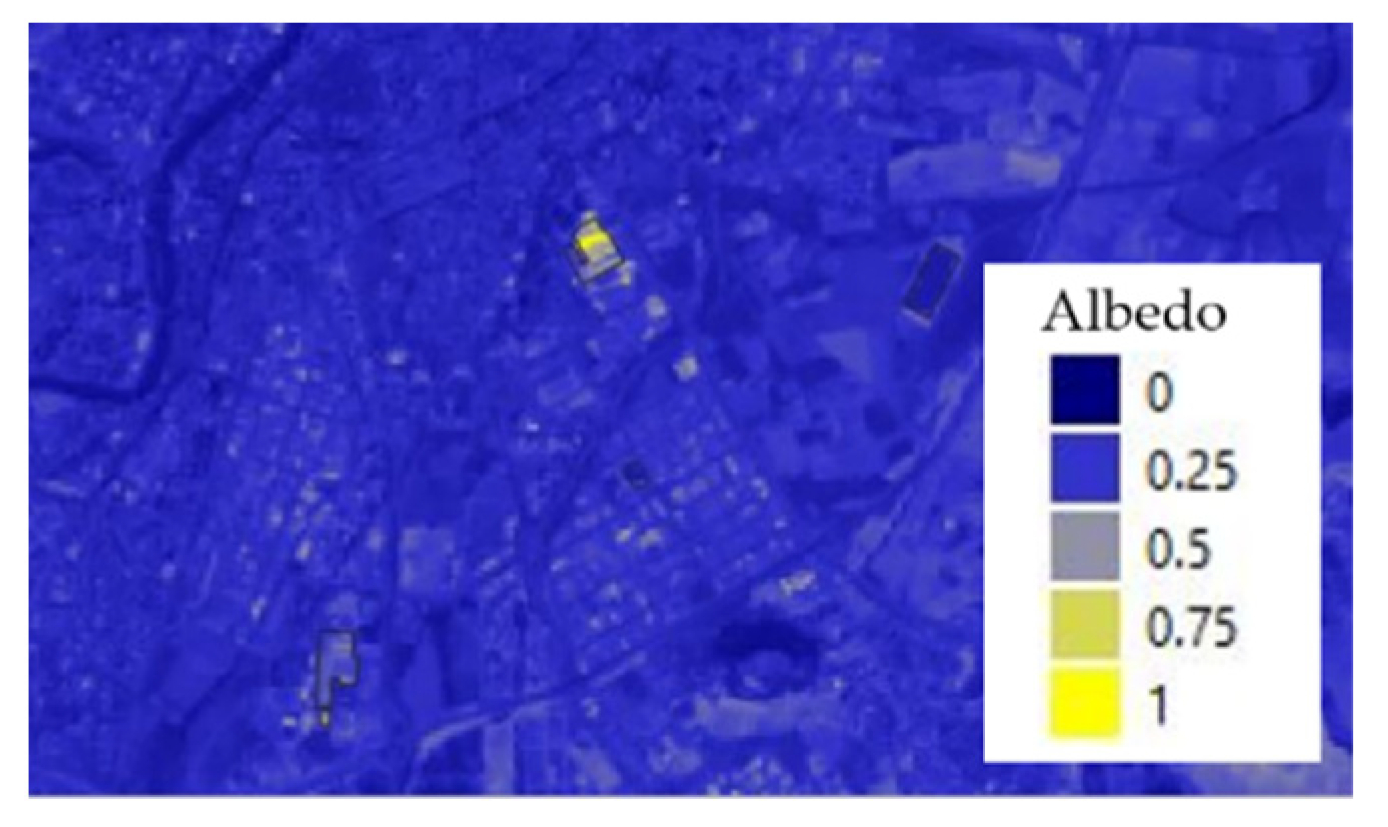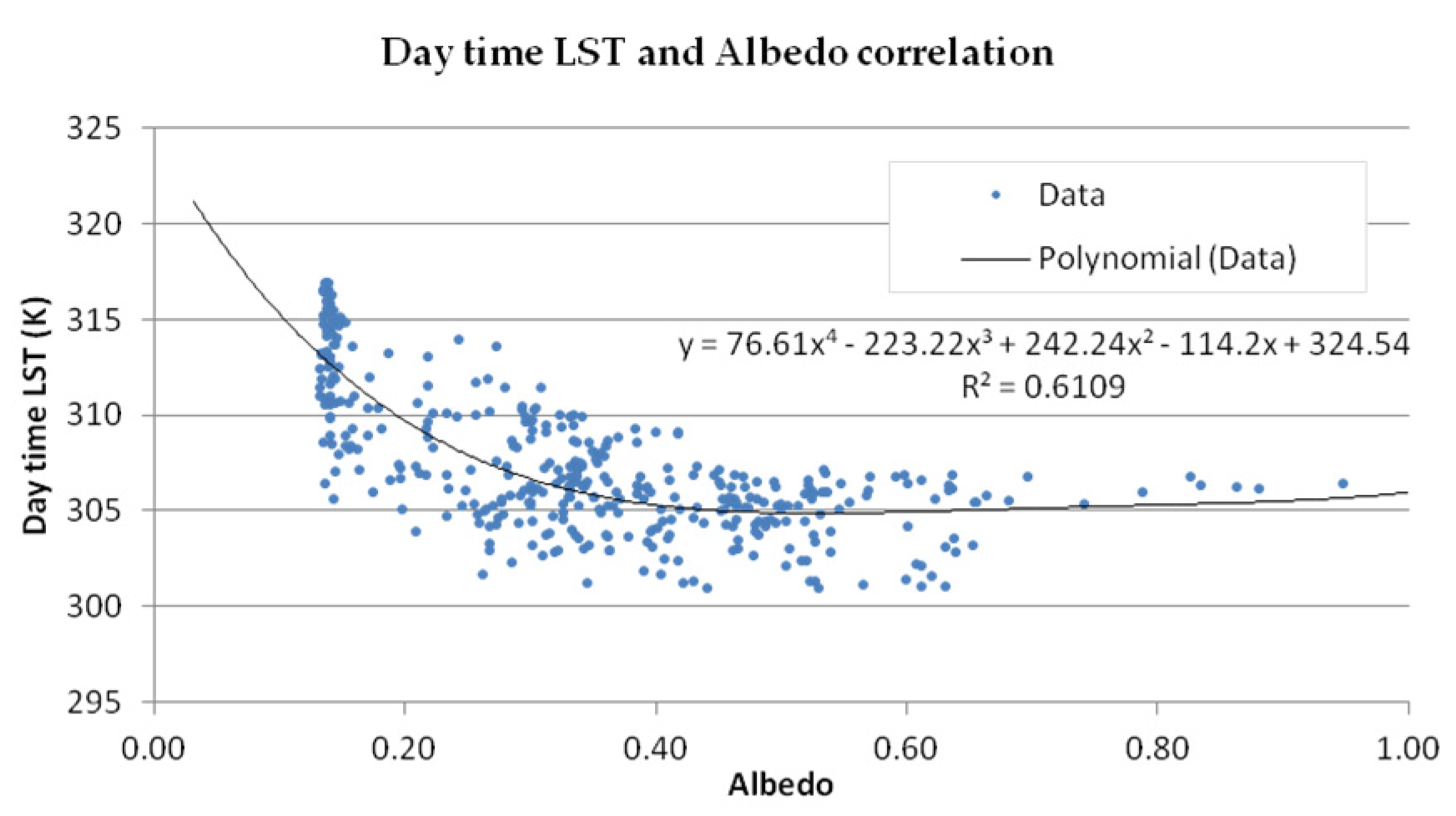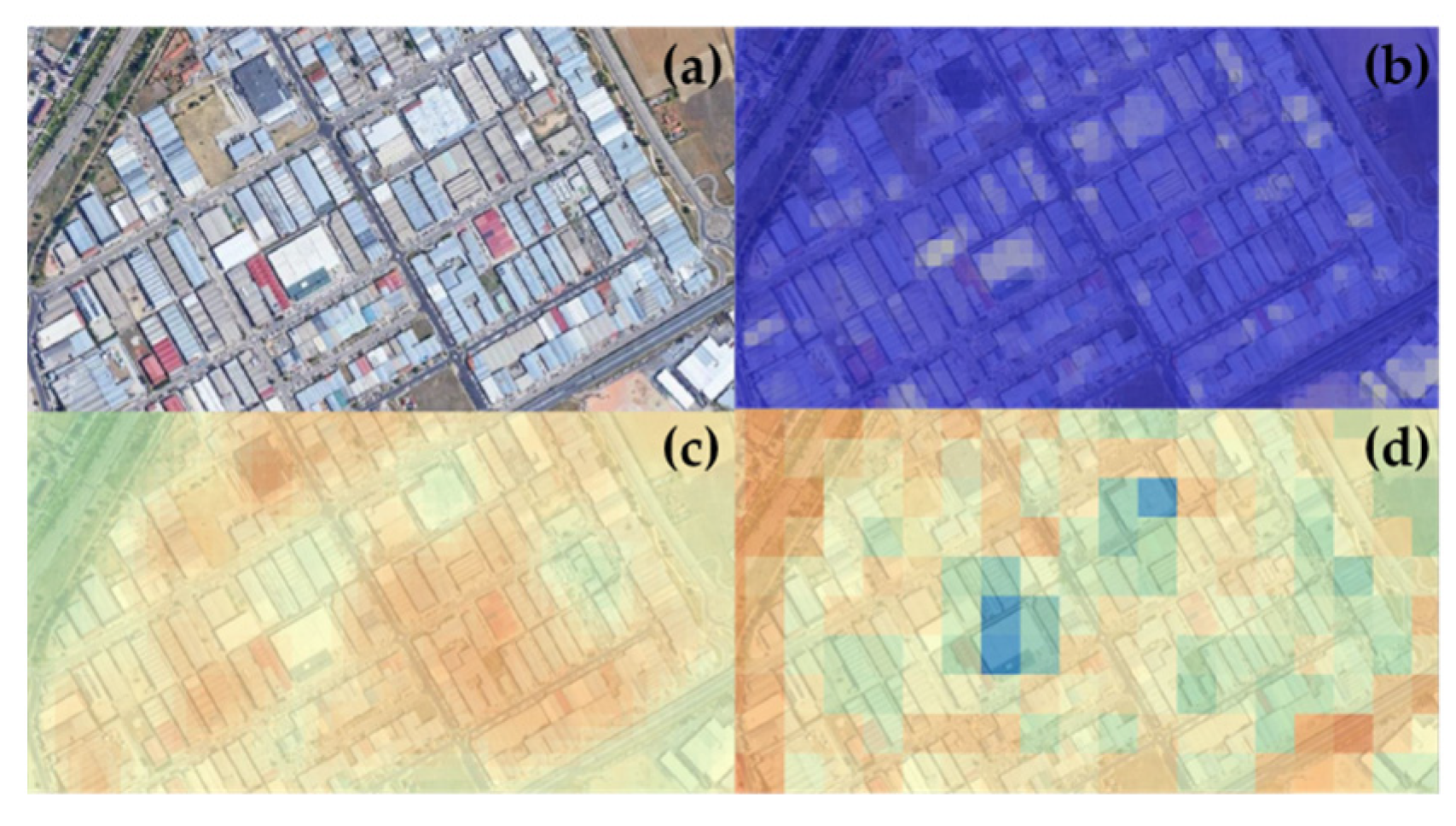1. Introduction
The increase in global population and the fast urbanization and industrialization concentrated in big cities have provoked a great revolution in land use worldwide. This revolution is accompanied by an important thermal change, creating a thermal disequilibrium between urban and rural areas. This thermal disequilibrium is known as the Urban Heat Island (UHI) effect, where heat is accumulated in big cities at higher rates than in rural areas, and consequently, surface temperature is higher in cities. This effect is best appreciated at nighttime due to the absence of direct heat due to solar radiation.
A special case of UHI is Extreme UHI (E-UHI), also known as heat point, which is located in industrial areas with extremely high temperatures [
1]. These industrial areas are characterized by a lack of vegetation and the presence of big factory sheds, frequently hosting activities requiring high temperatures, such as steel plants and thermal energy installations. In industrial buildings, the parameter that determines the temperature rise is the material of the building envelope, mostly the material of the building roof, as this is the main area of heat emission from the inside but also of heat absorption from the outside.
Albedo is the fraction of incoming radiation that the surface reflects, with values from 0 to 1 for lowest and highest reflection, respectively. Albedo, the same as Land Surface Temperature (LST), is a key parameter for the study of the effect of UH and can serve as a measure for its mitigation. An example is the “Cool Roofs” [
2], which are characterized by high values of albedo for high solar reflectance.
In addition, both parameters of albedo and LST can be studied on a large scale by using satellite imagery in the infrared spectrum, visible band and short-wave infrared for the albedo (0.2–3 µm), and thermal infrared for LST (7–14 µm).
This work studies E-UHI in industrial areas in Valladolid (Spain) as a case study for the determination of the correlation between albedo and LST, showing that the building roofs with high albedo values reach lower temperatures, as in [
3], but by using satellite imagery instead of a spectrophotometer towards the design of a generalized methodology.
2. Materials and Methods
2.1. Case Study
The city of Valladolid (Spain) was selected as representative for the study. There are 6 industrial areas in different locations within the city. Seven factory sheds were selected for the study, reaching a total surface of 40 ha (
Figure 1).
2.2. Materials
Albedo and LST were calculated using data acquired by satellite platforms. Particularly, images from Landsat-8 satellite (OLI and TIRS sensors) and Terra satellite (MODIS and ASTER sensors) were used with spatial resolutions of 30 m (Landsat8), 1000 m (MODIS), and 90 m (ASTER). OLI, TIRS, and MODIS were used to calculate daytime LST, ASTER provided a pre-processed image of nighttime LST, and OLI was used to calculate albedo. The reason for the use of different sensors in daytime/nighttime studies is the passing time of each platform: Landsat 8 passes over Valladolid at 11:00, meanwhile TERRA passes at 12:00 during daytime and also at 22:20 during nighttime. Further information about these sensors and their technical characteristics can be found in [
4,
5,
6].
2.3. Methods
2.3.1. LST
LST was computed with the methodology presented in [
7], which is based on single-channel methodologies (
Figure 2).
2.3.2. Albedo
Albedo is a parameter with a complex computation due to the high number of variables of influence [
8]. Thus, there are numerous methodologies and strategies for albedo computation. In this study, the methodology from Baldinelli was applied [
9] because it was performed in an urban area, particularly for factory sheds (
Figure 3). Baldinelli’s methodology provides good results in urban areas because it takes into account the anisotropy of the surface. Albedo was computed in this case from Landsat8 imagery (OLI sensor).
3. Results
The results of the study show the existence of a negative correlation between albedo and daytime LST (
Figure 4), with R
2 equal to −0.6109. This correlation confirms the theory that high values of albedo (reflected radiation) correspond to lower values of daytime LST (thus, lower heat absorption).
A detailed view of the roofs under study shows that roofs with high albedo values and low daytime LST also present lower nighttime LST than roofs with low albedo (
Figure 5). Color correspondence can also be seen, where dark roofs usually correspond to low albedo values and light roofs present high albedo. However, nighttime LST shows results independent from the value of albedo, mainly due to the thermal properties of the building interior and its capacity to retain heat.
4. Conclusions
The analysis of albedo and daytime LST in the roofs of factory sheds in the city of Valladolid shows a negative correlation between the two parameters in such a way that low albedo (dark color) roofs present higher LST than high albedo (light color) roofs. In addition, low albedo roofs also present higher nighttime LST.
Thus, this study demonstrates that the selection of construction materials is key for avoiding or reducing the UHI effect, reinforcing existing studies of albedo and the use of green roofs as alternative strategies [
10]. Furthermore, satellite imagery has proven its suitability for this analysis, allowing its repetition in any city and any season of the year.
Author Contributions
Conceptualization, S.L. and P.A.-A.; methodology, P.A.-A.; software, M.S.-A.; validation, P.A.-A., S.d.P. and S.L.; resources, P.A.-A.; data curation, M.S.-A.; writing—original draft preparation, P.A.-A.; writing—review and editing, M.S.-A. and S.d.P.; visualization, S.d.P.; supervision, S.L.; funding acquisition, S.L. All authors have read and agreed to the published version of the manuscript.
Funding
This research was funded by Cátedra Iberdrola VIII Centenary of the University of Salamanca; the Junta de Castilla y León with the Fondo Social Europeo through programs for human resources, grant number EDU/601/2020; and the Ministry of Education, Culture and Sports (Government of Spain) through human resources, grant number FPU19/06034.
Acknowledgments
The authors want to thank the Spanish Ministry of Education, Culture and Sports for providing an FPU grant (Training Program for Academic Staff) to the corresponding author of this paper.
Conflicts of Interest
The authors declare no conflict of interest. The funders had no role in the design of the study; in the collection, analyses, or interpretation of data; in the writing of the manuscript; or in the decision to publish the results.
References
- Liu, S.; Zhang, J.; Li, J.; Li, Y.; Zhang, J.; Wu, X. Simulating and mitigating extreme urban heat island effects in a factory area based on machine learning. Build. Environ. 2021, 202, 108051. [Google Scholar] [CrossRef]
- Synnefa, A.; Santamouris, M. Advances on technical, policy and market aspects of cool roof technology in Europe: The Cool Roofs project. Energy Build. 2012, 55, 35–41. [Google Scholar] [CrossRef]
- Prado, R.T.A.; Ferreira, F.L.E.S. Measurement of albedo and analysis of its influence the surface temperature of building roof materials. Energy Build. 2005, 37, 295–300. [Google Scholar] [CrossRef]
- Roy, D.; Wulder, M.; Loveland, T.; Woodcock, C.E.; Allen, R.; Anderson, M.; Helder, D.; Irons, J.; Johnson, D.; Kennedy, R.; et al. Landsat-8: Science and product vision for terrestrial global change research. Remote Sens. Environ. 2014, 145, 154–172. [Google Scholar] [CrossRef] [Green Version]
- Borbas, E.; Menzel, P.; Gao, B. MODIS Atmosphere L2 Water Vapor Product; NASA MODIS Adaptive Processing System, Goddard Space Flight Center: Greenbelt, MD, USA, 2015. [Google Scholar]
- Yamaguchi, Y.; Kahle, A.B.; Tsu, H.; Kawakami, T.; Pniel, M. Overview of advanced spaceborne thermal emission and reflection radiometer (ASTER). IEEE Trans. Geosci. Remote Sens. 1998, 36, 1062–1071. [Google Scholar] [CrossRef] [Green Version]
- Sánchez-Aparicio, M.; Andrés-Anaya, P.; Del Pozo, S.; Lagüela, S. Retrieving Land Surface Temperature from Satellite Imagery with a Novel Combined Strategy. Remote Sens. 2020, 12, 277. [Google Scholar] [CrossRef] [Green Version]
- Gueymard, C.A. Direct and indirect uncertainties in the prediction of tilted irradiance for solar engineering applications. Sol. Energy 2009, 83, 432–444. [Google Scholar] [CrossRef]
- Baldinelli, G.; Bonafoni, S.; Rotili, A. Albedo retrieval from multispectral Landsat 8 observation in urban environment: Algorithm validation by in situ measurements. IEEE J. Sel. Top. Appl. Earth Obs. Remote Sens. 2017, 10, 4504–4511. [Google Scholar] [CrossRef]
- Wong, N.H.; Tan, C.L.; Kolokotsa, D.D.; Takebayashi, H. Greenery as a mitigation and adaptation strategy to urban heat. Nat. Rev. Earth Environ. 2021, 2, 166–181. [Google Scholar] [CrossRef]
| Publisher’s Note: MDPI stays neutral with regard to jurisdictional claims in published maps and institutional affiliations. |
© 2021 by the authors. Licensee MDPI, Basel, Switzerland. This article is an open access article distributed under the terms and conditions of the Creative Commons Attribution (CC BY) license (https://creativecommons.org/licenses/by/4.0/).
